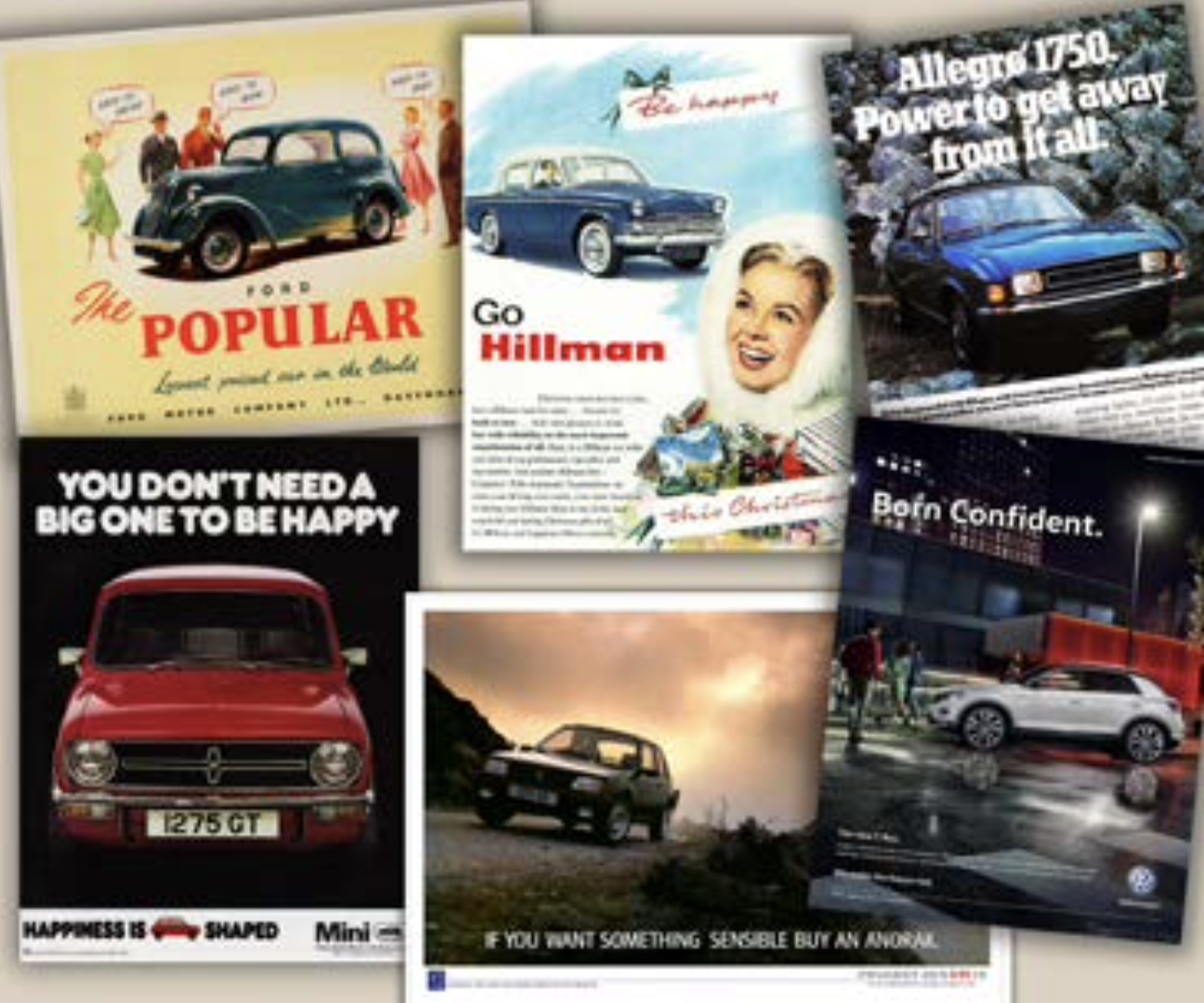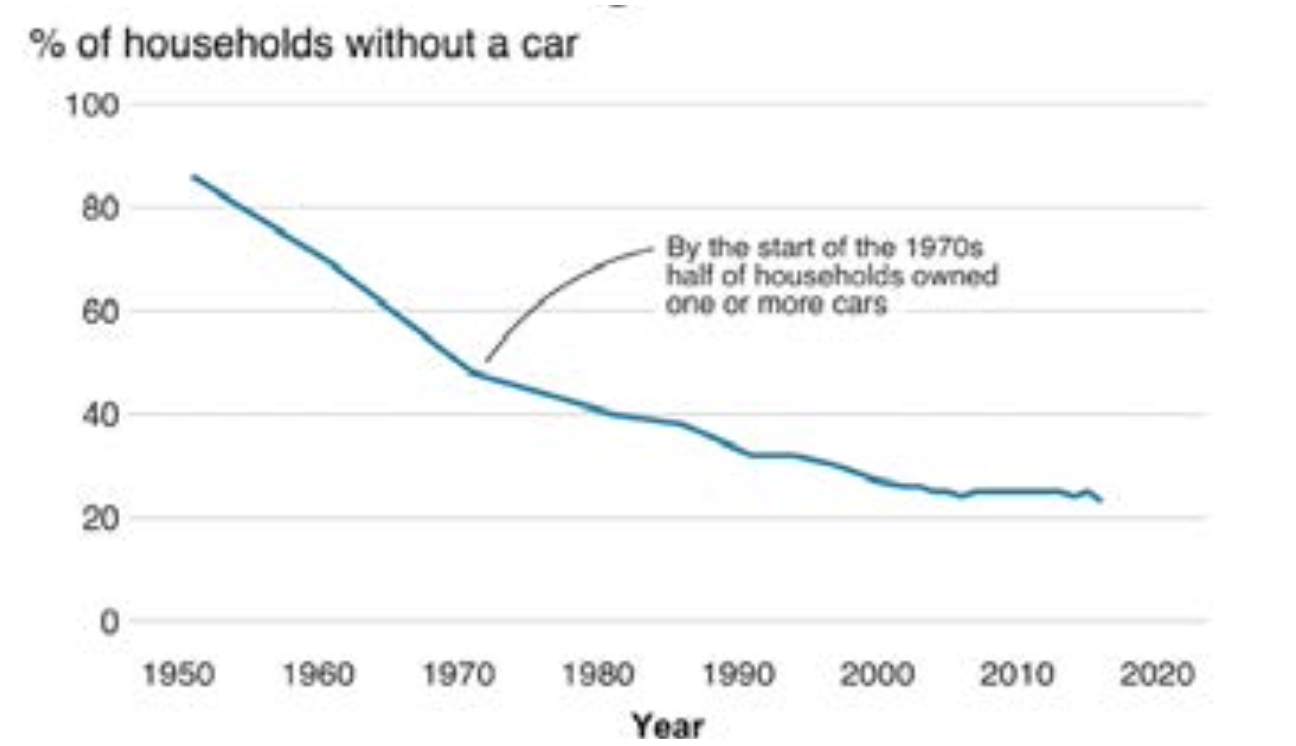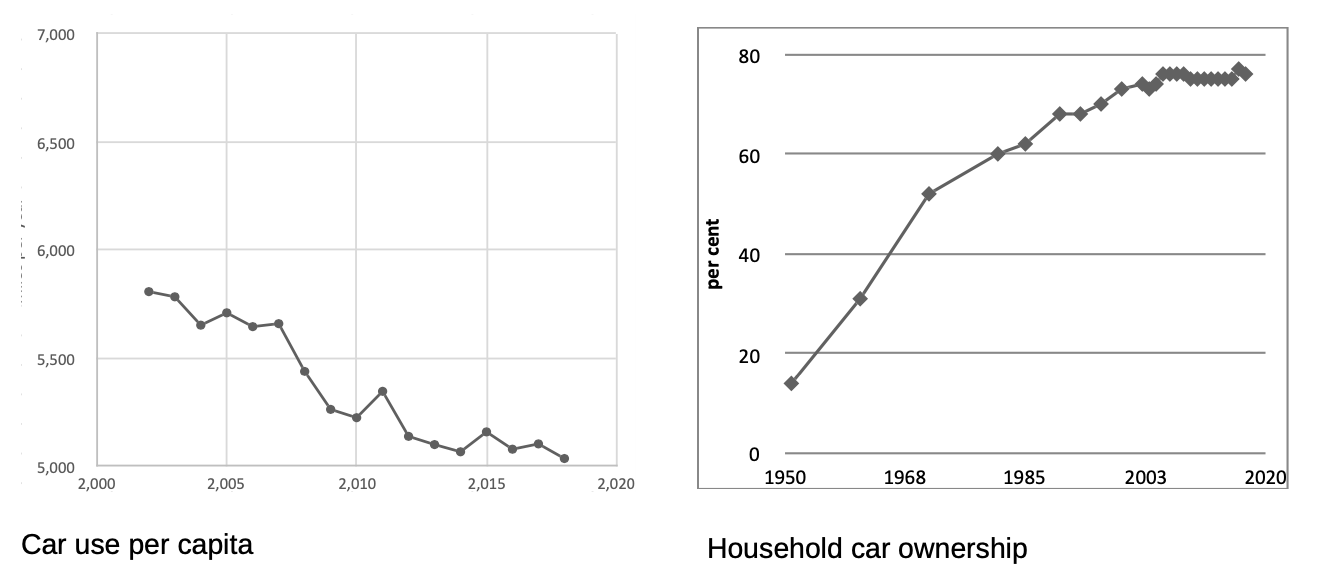TAPAS.network | 5 September 2023 | Commentary | David Metz
Car dependence - an interesting concept but not one that seems capable of building into practical transport policy-making

Catering for car use has been a key element of transport behaviour and therefore policy-making for the past 70 years or more. Recognised as a concern for its implications beyond just mobility, transport thinkers have sought to identify the driving forces and how they may be addressed. But believes that the concept of car dependence is not really helpful. Here he argues that understanding the role of the car is a much more complex and wide-ranging challenge.
THE CONCEPT OF Car Dependence was first articulated by my esteemed fellow TAPAS columnist Phil Goodwin nearly three decades ago [1]. It has achieved considerable backing from transport planners and academics who have long been concerned with the detrimental aspects of car ownership and use, and how this has become embedded in both practical lifestyle decision making by many individuals, and in our popular culture. The proponents of ‘car dependence’ thinking see reducing this behavioural paradigm as contributing to lessening these harms. Recently, reducing car use has been argued by many analysts and policy makers as an essential component in meeting Net Zero carbon reduction commitments.
I was recently invited by the journal Urban Planning to contribute to a special issue on the topic ‘Car Dependency and Urban Form’, addressing how future urbanisation and urban development could be shaped in a less car-oriented manner. This I was happy to do , but given the evident attractions of the car, I have become somewhat sceptical of optimistic ambitions for reducing car use within the character of the build environment we have inherited, and that forms the vast bulk of the urban environments in developed economies. I therefore proposed a contribution based more upon the car users’ perspective of car dependence. My paper is available [2], as is the whole issue [3] in this open access journal, though I felt it could be helpful to those more directly concerned with local transport policy and practice for me to summarise the main elements of my thinking here.
The current critique of car ownership and use, as embraced by the concept of car dependence, has a two-fold thrust: Challenge to the existence of locations where the car is the only feasible means of access, particularly where other modes of travel might be provided; and Challenge to ‘inappropriate’ car use in locations where other modes are available in the form of public transport and active (person-powered) travel. In this latter context, the term ‘car dependence’ has some resonance with other kinds of undesirable dependence, such as on alcohol or drugs, perhaps best described as ‘unhealthy lifestyle’.
Nevertheless, the practical impact of the critique of car dependence on materially influencing travel behaviour has been, at best, to date quite limited. What has been observed, however, are indications of a cessation of growth of car use and household car ownership since the turn of the century, following the previous rapid growth in the second half of the last century.
Selling the car - an increasingly sophisticated message

Marketing the car has developed as a significant cultural activity with the growth of the consumer society since World War 2. It began with a relatively straightforward message about the convenience and pleasure of motoring, through to comment relating the ownership of particular vehicles to the expression of the buyer’s individuality and status.
So, the question to be asked is why car dependence has generally persisted, despite analytical approaches, and some political positions and transport policy orientations, that favour its decline, and seek to engineer the public realm to confront it. In broad terms, the answer is two-fold. First, the widespread and increasing adoption of the car over now almost the past century in the developed world proceeded in parallel with the development of a very different built environment to the pre-existing one, within which are found the origins and destinations of nearly all trips- housing, shopping, education, leisure and more. Expeditious door-to-door travel by car has made possible access and connectivity to a wide range of people, services, activities and destinations to which we have become habituated as the essential ingredients of modern life, individualism, and the ‘consumer society’. As with path-dependent processes generally, reversal is difficult without loss of benefit. Second, car ownership (and use) is demonstrably intrinsically attractive to a large proportion of the population, and a large industry has come into being to satisfy this desire.
Utility of the car
The attractions of the car, inter alia, are exemplified, paradoxically, by the city of Copenhagen, famous for its cycling, about which I wrote in LTT of 28 June 2021 [4]. Here, in the Danish capital, in terms of trip mode share, ten times more use is made of bikes than in London, yet car traffic is only slightly less. The little appreciated feature of Copenhagen is that public transport use is meanwhile half that of London. So, it is possible to get people off the buses onto bikes that are cheaper, healthier, environmentally better and no slower on congested urban roads, but harder to attract drivers out of their cars, even in a small, flat city with excellent cycling infrastructure and a strong cycling culture. It is likely that most of those motorists in Copenhagen have bikes at home that they use for other purposes.
Data from other European cities show that Amsterdam is similar to Copenhagen with a high share of cycling and a modest share of public transport use, whereas cities such as Vienna and Zurich, with historic trams systems, have high shares of public transport use and modest shares of cycling. What is not easily found are cities with high mode shares of both cycling and public transport.

Since the 1950s cars have become a more and more standard feature of households. Source: National Travel Survey
So why are cars widely used even in cities that encourage other modes of travel? The answer surely is that cars are useful for carrying people and goods, including child seats and other equipment that is regularly used, moving around shopping and other household items, as well as for making trips longer than would be comfortable by bicycle. The car is well-suited for meeting needs for access to people and places, including for arranging trips with a chain of destinations; for door-to-door travel where there is road space to drive without unacceptable congestion delays; and for the ability to park at both ends of the journey. Car travel generally requires less planning than trips by public transport, with digital navigation based on satnav devices a recently added means of selecting the quickest route.
Besides, the car offers flexibility, comfort, privacy and security, compared to public transport, particularly for people with mobility difficulties, and the degree of ‘control’ provided to people in their own transport mode contrasts with many people’s emotional concerns at being dependent on the vagaries of public transport. Not to mention the reflection of our culture of individualism and independence of action that has become a hallmark of modern society. This was well illustrated when following lifting of restrictions on daily activities and travel imposed during the coronavirus pandemic, public transport was deemed less attractive on account of the perceived risk of infection, and car use revived much more rapidly back to close to pre-pandemic levels.
Car travel may also feel less costly than public transport, particularly with a full load of passengers and the perceived low marginal cost of individual journeys once the asset investment has been made. Car ownership requires a commitment to pay the costs of purchase, servicing and insurance, so trading off large one-off payments for low marginal costs at the time of use. Such sunk costs are largely disregarded when making a choice between car use, active travel and public transport for an intended trip.
Another factor is the so-called ‘time poor’ society we now have. Importantly, this has heightened an awareness that the amount of travel that can be undertaken is limited by the time available in any one day, and all the activities that must (or at least are desired) to be fitted in. For settled populations, average travel time has amounted to an almost constant level of about one hour a day for a least the past fifty years of the National Travel Survey prior to the pandemic [5], and likely since humans transitioned from hunter-gatherers to farmers. Accordingly, faster travel allows greater access within the travel time available. Car travel is generally faster, door-to-door, than other modes over short to moderate distances, which increases people’s access to desired destinations. Access increases approximately with the square of the speed of travel, so that urban car travel at, say, 30 km per hour allows four times the access than does cycling at 15 kph, and twenty-five times more than walking.
The value of access to people, places, activities and services, of the choices and opportunities that ensue, is surely the main reason for the popularity of the car for both short-to-medium journeys where there is adequate road space, and for end-to end longer trips not just linking key nodes where the alternative modes, rail or air travel, may be more attractive.
Yet the attractions of car ownership go well beyond the utilitarian.

In the past few years the growth in car ownership and use appears to have levelled off as these charts from the National Travel Survey suggest.
Attractions of car ownership
There is an extensive and generally persuasive research literature on why the car is seen as attractive, quite apart from its utility in making journeys. This deals with the symbolic and affective aspects of car ownership and use. Cars can be symbols of both social identity and status as well as of personal identity. Affective aspects refer to emotions that include pleasure and pride, freedom and being in control. I do not attempt to summarise all these diverse finding in this article - though commend an awareness of them to all those seeking to influence travel behaviour - but will simply mention some visible indicators of the attractions of ownership.
The fact that cars are generally parked for 95% of the time is a good argument for the economic benefits of car sharing, which would make fuller use of a costly capital investment. But the limited adoption of this logical practice also indicates something significant about human values. These include the appeal of the car to individual owners, standing ready use when required, including at short notice, but also for the non-use benefits (emotional as well as practical) of vehicle ownership.
A particular indication of the non-use attractions of the car is the growth of sales of sports utility vehicles (SUVs), larger, heavier and more costly than the vehicles they replace. In 2021, SUVs accounted for more than 45% of global car sales. While there may be some practical advantages, it seems likely that this growth reflects positive feelings about ownership of these vehicles, and their perceived benefit - including a sense of extra protection against the rest of the world around them, considerations underpinned by extensive and sophisticated marketing as explored recently by my fellow contributor John Dales [6].
An Indian motoring journalist recently observed: ‘Cars remain deeply aspirational in India, and it’s common for new buyers to offer prayers when a family adds a new vehicle. The upgrade from a two-wheeler to a four-wheeler is also a hugely important status symbol.’ More generally, acquisition of a car in a low-income country represents a visible step towards modernity.
Reducing car dependence
Given both the utility of the car for getting from A to B and the wider attractions of ownership felt by many, what are the options for reducing what is described as car dependence? These seem to fall broadly into three categories. The practical: providing acceptable alternative modes of travel, and making car use less attractive than the alternatives, ie the carrot and the stick. And, alongside these mobility management dimensions, lessening the good feelings about car ownership and use.
In terms of creating an appropriate land use and planning framework, there is particular concern when new housing on greenfield sites is planned without alternatives to use of the car, supposedly trapping the residents into car use. But a question that arises is whether those who purchase these homes do indeed feel deprived on that account by their limited travel options, or whether they happily choose to live in such locations because they are positive about driving and are pleased to have plenty of parking space for their cars, and potentially uncongested local roads
While there has been research into how attitudes, behaviours and residential choices influence the take up of sustainable travel options within urban areas, empirical investigation is needed to understand to what extent a new greenfield housing development results in involuntary or voluntary car dependence in suburban, peri-urban and rural areas, albeit with deprivation for those residents who do not have access to a car. Given that these developments are built to sell, it is possible that most purchasers are content with a car-based lifestyle.
60 years on, politicians still seek to embrace the motor car

‘It is fundamental to the whole (Buchanan) Report that it accepts the motor vehicle as a brilliant and beneficial invention. It is in no sense restricting the motor car... We have to face the fact, whether we like it or not, that we have built our towns in entirely the wrong way for motor traffic. We want an entirely different type of town.’
Ernest Marples, 1963
“I just want to make sure people know that I'm on their side in supporting them to use their cars to do all the things that matter to them.”
Rishi Sunak 2023

While the planning of new settlements can and should include much more consideration of provision of alternative modes of travel to the car, the greater problem concerns the existing extensive acreage of built environment that has developed over the period since the middle of the last century as car ownership has become widespread. The result has been low-density development in Britain, where the car has facilitated access to people and places, allowing dispersion of opportunities for access to employment, housing, services, as well as to family and friends, in turn creating a landscape in which cars are seen as essential. This is not the low density of many north American cities, such as Los Angeles, where land is cheap and cities have sprawled, yet it is not the high density of European cities such as Paris or Barcelona either.
Against this backcloth, the scope for the planning system to reduce car dependence would appear very limited, particularly since the vast share of property, both residential and commercial, is owned privately. Besides, home-owners value attractive neighbourhoods and could not afford the cost of rebuilding, and would probably not happily embrace ‘densification’ taking place around them. Hence the ability to reduce car use through creation of ‘15-minute cities’ or ‘20-minute neighbourhoods’ is for the most part more of an aspiration that a reality in existing built environments.
Conversely, car dependence in economically vibrant rural areas may be seen as a positive feature, dangerous to challenge, since, without the car, depopulation would be likely as people move to cities for employment opportunities. When on trips to the interior of Spain out of the holiday season, I have been struck by how quiet are the villages and how little traffic there is on the good rural roads. I suspect the reason is that the population density of Spain is a third that of Britain, which means that the distances between attractive villages and towns where employment is located may generally be too great even for car commuting, leading to rural depopulation – not generally a problem in most of Britain.
Ways of making the car less attractive are well understood, so I will not itemise these here. A general limitation is the public acceptability of the adoption of such means, given the high level of household car ownership and use. Witness the current row about extending London’s ULEZ to the outer boroughs and the fearfulness of politicians in both main parties of being seen to be ‘waging a war on motorists’. The best opportunities are in city centres where congestion and parking availability limits car use, and where good public transport services are most economically feasible.
Mechanisms for lessening good feelings about car ownership are the least understood aspect of any attempt to address ‘car dependence’. There are research findings that feelings of pride in car ownership vary widely across countries, for reasons that are not apparent beyond the status associated with ownership in developing economies, as mentioned in India. Attitudes also vary within countries, with younger adults in developed economies making less use of cars, particularly when living, working and studying in or near attractive city centres. More generally, concerns about the environmental detriments arising from car use may prompt some to give up their cars, although it is difficult to predict how far such a movement might spread, particularly as the switch to electric vehicles reduces environmental anxieties, and the availability of public transport outside the main urban areas continues to decline.
Meanwhile, whatever steps policy makers and transport practitioners may take to steer people away from their cars, the marketing efforts of the highly competitive car industry will continue to identify motivations for the purchase and use of cars, while the engineering side will continue to innovate to develop more attractive products. The aim of these efforts to is instil positive feelings about car purchase and use, which tend to trump the countervailing efforts to reduce car dependence. This market context seems not likely to significantly change, as innovations associated with the current switch to electric propulsion yield vehicles attractive to drive, as well as receiving the endorsement of governments through financial incentives to purchase, including lower rates of taxation, and support for provision of electric charging facilities. More generally, the governments of countries in which car manufacturers and their supply chains are located are supportive of these businesses and their outputs, for reasons of both employment and industrial policy. There are no examples yet of countries, or even regions, happily seeing their car industry closing down, let alone actively striving to end it. ‘Just stop oil’ and protests against the fossil fuel sector do take place, and have tended to prompt quite a backlash, but ‘Just stop cars’ has to date been limited to some subversive advertising campaigns. A broader movement to that end would seem an unlikely near-term prospect.
Conclusions
It would be hard to deny that the car is one of the great inventions of modern life, and is justly popular for the access it makes possible to people and places, family and friends, jobs and homes, opportunities and choices. In developed economies, more households own cars than have children. Car ownership is widely associated with positive feelings, of pride of achievement and of self-esteem. It is undeniable that this popularity gives rise to the well understood detrimental aspects of car use, of which contribution to climate change is at the forefront of concern, but that connection is generally being addressed with some caution, understandably.
A policy-led direct assault on car dependence seems unlikely to succeed. Instead, it appears more productive to tackle the detrimental aspects of mass car use aspect by aspect, through evidence-based policies. Thus, it is prudent for the switch to electric propulsion that eliminates tailpipe emissions to be pursued independently of any general pushback against car traffic in favour of active travel and place-based street activities, other than where there is a clear public mood locally for that kind of lifestyle and neighbourhood, as there may well be in some places.
All in all, it seems to me that the concept of car dependence has proved to be less helpful for policy development than had originally been hoped. In major part this is because it has been anchored in an implied judgement by planners and researchers that has to date not commanded general popular support. This shows a contrast with the wider implications of climate change, where the attitudes of experts, the car industry and the public are broadly aligned in respect of the need for society to make the switch from oil fuels to electric propulsion. In the specifics of transport, meanwhile, personal mobility aspirations show little signs of being tempered by their potential contribution to an adverse climate outcome. Society’s overall car dependence may be broadly acknowledged as a problem, but as an individual condition it is not, which constrains the scope for policy interventions.
References and Links
-
Goodwin, P. (1995). Car dependence. Transport Policy, 2(3), 151–152.
https://doi-org.libproxy.ucl.ac.uk/ 10.1016/0967-070X(95)96744-6
-
Car Dependency and Urban Form Urban Planning Open Access Journal Vol 8, No 3 (2023)
https://www.cogitatiopress.com/urbanplanning/article/view/6286
-
Car Dependency and Urban Form Urban Planning Open Access Journal Vol 8, No 3 (2023)
-
Metz, D. in LTT 826 of 28 June 2021: What’s the Use of Cycling?
David Metz is an honorary professor in the Centre for Transport Studies, University College London, where his research focuses on how demographic, behavioural and technological factors influence travel demand. He spent part of his career as a senior civil servant in a number of UK government departments, both as policy advisor and scientist, including five years as Chief Scientist at the Department of Transport. www.drivingchange.org.uk
This article was first published in LTT magazine, LTT875, 5 September 2023.
You are currently viewing this page as TAPAS Taster user.
To read and make comments on this article you need to register for free as TAPAS Select user and log in.

Log in